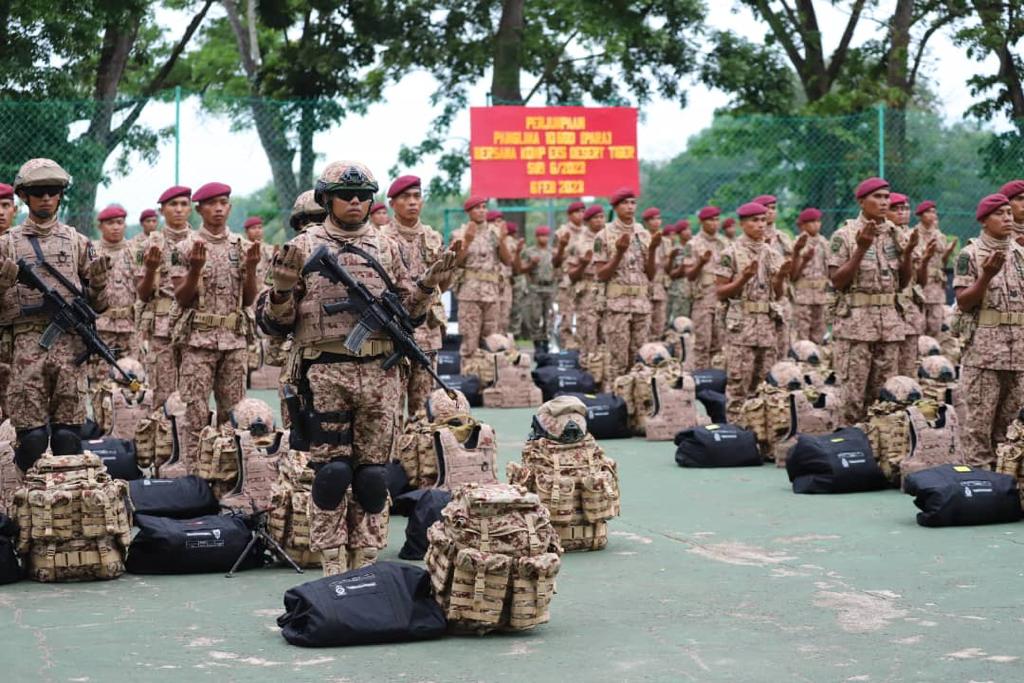
SHAH ALAM: The Army is sending a company strong of paratroopers to the United Arab Emirates for a three-week long bilateral exercise – Desert Tiger 6/23 – in the Middle East country. The bulk of the paratroopers are from Ninth Royal Malay Regiment (Para) which is part of the 10th Para Brigade. Other soldiers from the Malaysian Armed Forces are also likely to be part of the Malaysian contingent based on the heading published in a social media post by the brigade.
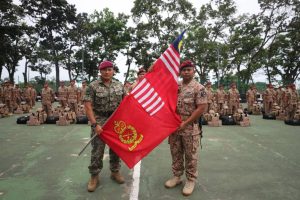
EKSESAIS DESERT TIGER SIRI 6/23 – UJI TAHAP KOMPETENSI KOMPENI TEMPUR PAC-ATM DI EMERIAH ARAB BERSATU (UAE)
MELAKA: Panglima Briged Ke-10 (Para), Brig Jen Khairul Azmizal Ahmad Natal telah menyempurnakan acara penyerahan Bendera Tentera Darat Malaysia kepada Pegawai Memerintah 9 RAMD (Para) serta menyampaikan mandat kepada Kompeni yang terlibat Eks DESERT TIGER Siri 6/23 di Emeriah Arab Bersatu bertempat di 9 RAMD (Para), Kem Terendak, Melaka pada 6 Feb 23.
Sebagai persediaan, kompeni ini telah melaksanakan Pre-Deployment Training (PDT) dalam Eks URBAN TIGER Siri 1/23 di kawasan am Kem Terendak, Melaka melibatkan aturgerak penyusupan taktikal secara Air Assault, seterusnya Ground Tactical Manoeuvre sebelum melaksanakan fasa ofensif dan defensif dalam konteks Operation in Build-Up Area (OBUA) sejak sebulan lalu.
Dalam ucapannya, Panglima 10 Bgd (Para), turut mengingatkan supaya mempamerkan tahap profesionalisme dan disiplin yang tinggi demi menjaga nama baik Tentera Darat amnya dan 10 Briged (Para) khususnya sepanjang Eks dilaksanakan bermula 8 Feb hingga 1 Mac 23 di UAE.
Eksesais Bilateral yang bakal diadakan ini adalah bagi memberi pendedahan operasi di padang pasir bagi menambahkan pengetahuan dan kompetensi anggota di samping mengeratkan hubungan ketenteraan antara kedua negara.
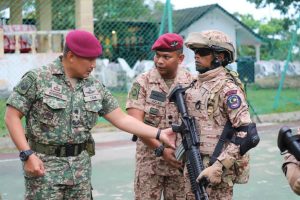
The Armed Forces has been sending troops to the Middle East since mid-2000s as Malaysia seeks better ties with the Arab countries. This includes the deployment of a RMAF Hercules aircraft to Saudi Arabia as part of the coalition against the Houthis in Yemen.
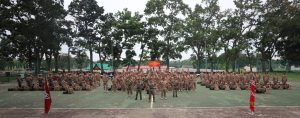
The Hercules were originally sent to Saudi for the evacuation of Malaysians from Yemen which had descended into a civil war. However, at least one Hercules remained there some four years later.
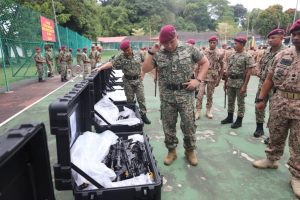
However, the deployment and training exercises were stopped in 2018 following a decision by the then PH government. The then Defence Minister Mohammad Sabu said the deployment and exercises of MAF to the Middle Eastern countries especially to Saudi was incompatible with the country’s stand of neutrality. He even said that the deployments were undertaken without prior approval by the Cabinet.
— Malaysian Defence If you like this post, buy me an espresso. Paypal Payment


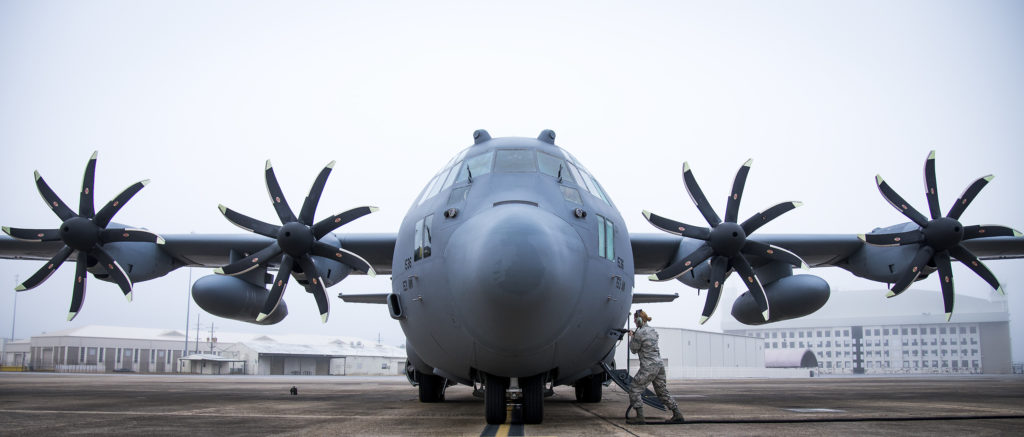

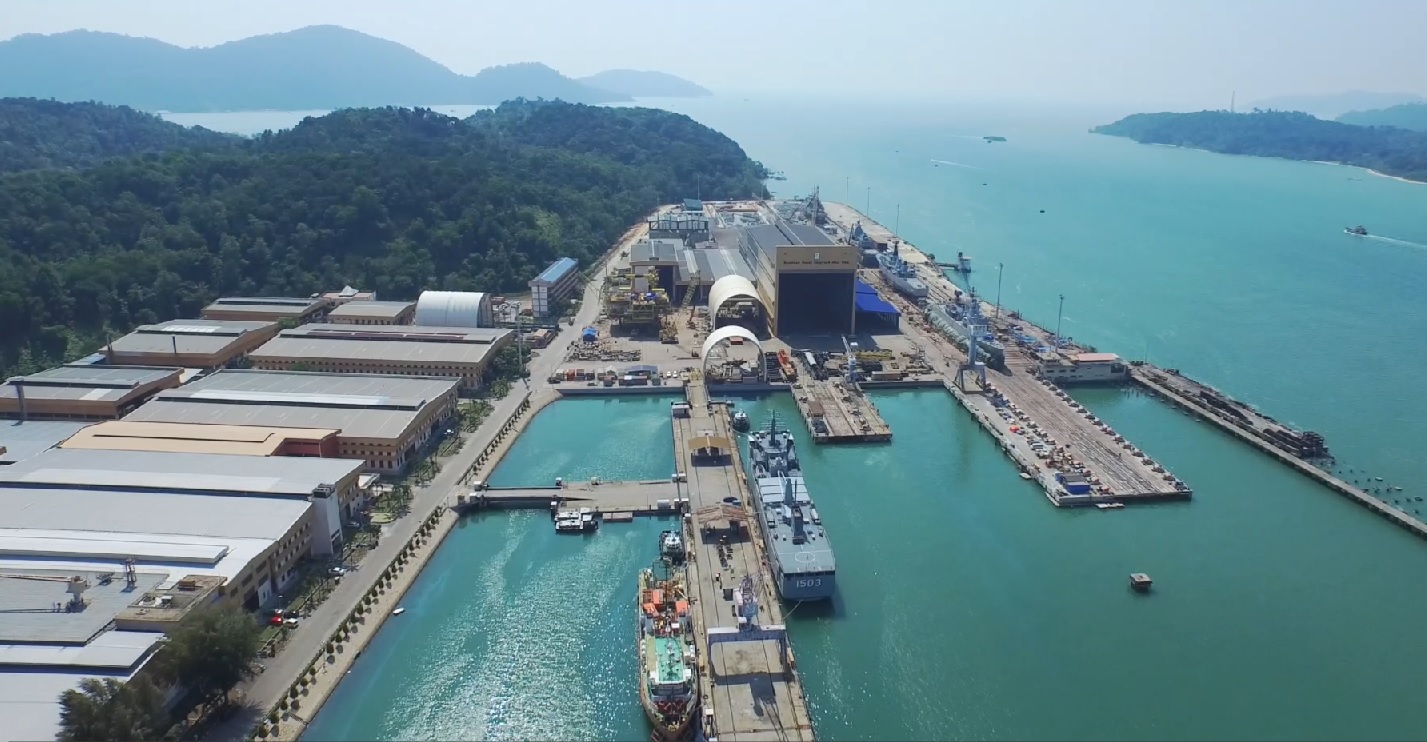
I never knew we had a need for desert camo. After all, where are we going to use it here anyways?
@Marhalim
On the iphone, if you click the postings it goes to an advertisement. Happened before the last time and you fixed it.
The decision to send a whole company is surprising as we normally send platoons to such exercises. We are in the midst of repairing ties with the UAE which we historically close but went somewhat downhill after the 2018 GE. At this time of the year it will be the cold and not the heat which will be an issue in the desert.
We sent more than a couple of Charlie’s and medical/security teams to Saudi in connection with Yemen but I’ll leave it at that.
It might be less than a company strong but since they stated its a company, I leave it at that.
yes on smaller screens it will do that. I will try to fix it again
”I never knew we had a need for desert camo.”
We had a desert variant of the tiger stripe pattern for troops in Afghanistan and a desert variant of the digital for troops who participated in the Saudi exercise years ago. Other countries which normally don’t operate in the desert but have desert camo for troops deployed in desert conditions would include South Korea; Japan, Singapore, Thailand, Romania, Czech Republic; Slovakia, Belgium, etc. I have several desert patterns from various countries.
We have been using desert camo since we had troops in Lebanon
From the pictures, the deployment is a company-sized force consisting of 3 platoons of 4 sections each. That is just around 100 personnel.
The way the weapons are dumped into the boxes (some with optics) really shows that the quartermasters are not trained properly to pack equipments for long range deployments.
I hope that all the weaknesses from this exercise would be written down to be studied.
Likely dump as not given the right equipment
No news on any assets procurement? Boring.
We sent more than a couple of Charlie’s and medical/security teams to Saudi in connection with Yemen but I’ll leave it at that.
The above statement is interesting as real life Battle Field Surgery and Medivac exposure and training in an invaluable experience. Alot can be gained from this. Question is how well equipped are our armed forces in this role? Do they gave sufficient medical field equipment to do field surgeries? How quick can our heli’s or aircraft be converted to the medivac roles?
“desert variant of the tiger stripe pattern for troops in Afghanistan”
We had troops in Afghanistan? I mean other than the HADR we did during earthquake disaster back then? Colour me surprised.
Charlie Tango – ”Question is how well equipped are our armed forces in this role?”
As well equipped and trained as we possibly can given the resources we have. Yes we have field hospitals.
At the end of the day the MAF is not equipped, trained or structured for protracted high intensity operations. It also does not have the manpower to replace in a short period any high casualties incurred.
Yes but we withdraw the unit as the Taliban has no time for us unlike the richer Middle East countries like UAE and Qatar
We are also clearly not prepared to fight at night.
Malaysian Army probably has the least NVG equipment among the armies in South East Asia.
”We had troops in Afghanistan?”
In Bamiyan province; based alongside a Kiwi reconstruction/civil team. The NATO channel did a short video on our troops which used to be on YouTube. We were there not on combat ops but humanitarian; it was a large Medical Corps contingent with security elements and a RMAF Charlie even landed at Bamiyan.
Akmal -”Boring.”
Then just read and comment on the not ”boring” stuff.
Wong – ”We are also clearly not prepared to fight at night.”
Correction. Some units are better prepared than others. Like how some units are better equipped than others.
Amidst all this talk about the needed hardware and other things; missing from the common narrative is the issue of manpower. The army is a small all volunteer force to begin with; has no large numbers of reserves and there isn’t a large pool of manpower which is available. As such if we are faced with a situation in which we suffer large number of casualties; replacing them will be a problem. Also, often forgotten or overlooked is that there’s such a thing as tooth to tail ration; x percent of men in a combat unit will be non combat elements.
We are not capable to fight a protracted war. We are not capable to fight a conventional war.
So what good is our ATM for? RM16b annually in preparation to fight a short border skirmish with a neighbour.
As that’s is the expectations of the government since our inception. Apart from the Konfrontasi which we had help from the British, Oz and NZ, we remained part of the fortunate region prosperity. That is the reason we have been told that there is no reason to arm ourselves to the gills like our southern neighbour. It is ironic that the southern neighbour decision to bolster their defence was due to the rhetoric of Tun Mahathir. Who at the same time decided there is no need to boost our defence spending as we are not going to war with anyone.
Hasnan – ”So what good is our ATM for?”
With the exception of the SAF please tell me which regional military [all of which for decades were orientated towards internal security] is trained, structured and equipped for a high intensity a protracted war? Think…. Do we have the money, manpower, equipment; stockpiles of ammo, spares and other consumables?
After the SAF the army which camos the closest but which still has various issues is the RTA; in the 1980’s when the Vietnamese were in Kampuchea and all of us were worried the RTA got quite a bit of heavy gear but having heavy gear and being able to conduct joint combined arms ops is a different thing. Following the declaration of the EEZ and driven by the Vietnamese invasion of Kampuchea we launched PERISTA which was focused on external security but there was no continuity.
Hasnan – ”We are not capable to fight a conventional war.”
Correction… Not ”capable” of fighting a high intensity protracted conventional war… BTW with the exception of a select few; most NATO armies are also not capable of fighting a high intensity protracted conventional war. The Ukraine is a good example of a country which was ready but then it had a large standing army; a fairly large pool of trained reserves; a large pool of manpower it can rely on and even before external aid came filtering in it had a very large stocks of weaponry, ammo and various things accumulated from the Soviet era.
“In Bamiyan province”
I see, we came for the HADR and stayed for the humanitarian effort. So it wasn’t in support of US War on Terror then. Or did we had to get tacit US approval to be there?
“there isn’t a large pool of manpower which is available”
Depends on how one looks at it. When comes time, we got the option of civilian volunteers, drafts, etc. We have 6million from Undi18 alone so that tells you how much there will be if forced to use all available.
Basically, it’s a tacit approval of GWOT. They chose Bamiyan as it was the most peaceful province at that time
”So it wasn’t in support of US War on Terror then. ”
No it wasn’t; look it up; a matter of public record what we did and why.
Our support for the ”War On Terror” was allowing increased overflights for U.S. aircraft; sharing intel; allowing suspected terrorists to be extradited; cooperating over issues related to the AQ Khan network [a certain factory in Shah Alam]; etc, – also a matter of public record; mentioned in various books/articles. On another matter 2 of the USS Cole attackers had a meeting here months before.
” we came for the HADR and stayed for the humanitarian effort.”
The contingent comprised mainly Medical Corps people. We did not perform HADR [the treatment of Afghan refugees in a field hospital was in Pakistan during a different period]. We did civil outreach programmes for the locals – medical/dental care; family planning [no joke]; providing them with the means to get water; etc. The Kiwi team we shared a compound with was also engaged in something similar. Bamiyan as we all know is home to the Shia Hazaras and is where the Talibs blew up the giant centuries old Buddha statues.
BTW the first flight in was via a USAF C-17 which picked the contingent up from Qatar after they were flown there by a RMAF Charlie.
”Or did we had to get tacit US approval to be there?”
They were happy we were there.
”Depends on how one looks at it.”
”We have 6million from Undi18”
Out of that 6 million a significant chunk won’t be suitable for military service and of those that are suitable on paper; some might later turn out unsuitable and not all will be sent to combat units – that’s the way I ”look at it”.
The CIA Factbook and Military Technology Almanacs used to give an ”available manpower” or portion of the population suitable for military service numbers but paper numbers don’t tell the whole story.
Even a pacifist nation like Japan is preparing for war, yet here we are again contemplating cutting our defence budget
“a significant chunk won’t be suitable for military service”
Even if an exorbitantly high ratio of 50% illsuited for combat, that still leave a strong 3million manpower. Available human resource is the least of our problems – that’s the way I ”look at it”.
”Available human resource is the least of our problems – that’s the way I ”look at it”.
You ”are looking at it” superficially and making claims which you’re convinced is true.
Manpower is and will remain to be a problem for us. As it stands many of our units are below authorised strength; there are small numbers of personnel trained for niche positions requiring hard to obtain and easily perishable skills and we induct relative small numbers of men annually in an already small army which is all volunteer. On top of that there’s such a thing as ‘tooth to tail ratio” – x people in the army will not be in combat positions. You have any idea what the average rifle strength is in our units? We also BTW do not have the facilities [never mind the gear] to induct and train large numbers of men.
As I said; numbers give a false illusion. Just because on paper there may be ‘x’ million men suitable for military service doesn’t mean even half of them in actuality will be suitable or will be sent to combat units. Even the Ukraine with a slightly larger population and a larger pool of trained manpower was unable to gain manpower in the millions and are hard pressed to replace losses.
That’s the ”way to look at it” irrespective of how you’ll insist otherwise.
“Manpower is and will remain to be a problem for us”
That’s your opinion but that doesn’t make it real. As I said before there are many reasons why ATM finds it hard to get manpower, and whatmore people are already complaining it is overbloated.
However the troubles of ATM doesn’t factor in that the general populace, we still have a very big segment of youths which is why Undi18 got so much traction. 6million (or 3million whichever you want “to look at”) is no small numbers.
Numbers gives a false illusion? Maybe to you but numbers are numbers and they are real irrespective of how you’ll insist otherwise.
Hasnan “Even a pacifist nation like Japan is preparing for war, yet here we are again contemplating cutting our defence budget”
They had nuclear capable ballastic missile flying over their head once every few moon while PLAN ship buzzing off the SCS which can threaten their energy & food import at the same time intruding into their territorial waters & airspace
Thus the need for us to get quality force multiplier assets instead of a little of this and that…
The ATM being a closed service also could not provide a good career path for most officers, who quit after 10 years of service. Most becoming small business enterpreneurs. A big loss for all the training provided.
Those people who left service at 10 years are mostly those who were employed under the short service scheme. It is the same scheme that we followed from the British
Manpower is one of the biggest problems of any service, not just Malaysia. Its all over the world.
‘That’s your opinion but that doesn’t make it real”
You are the one talking mostly from ”opinion”. What I actually know is based on what I’ve been told from those in the position to know. I also don’t have a history of making claims without putting some effort in ensuring what I say has some accuracy in it…
” As I said before there are many reasons why ATM finds it hard to get manpower”
Yes you’ve said many things on various things and some are a bit off to put it mildly.
Back to topic the MAF has a cap on the manpower it can induct and to begin with only small numbers of men/women are inducted annually. Of the numbers it gets some later leave prematurely and not all go to combat units.
”Numbers gives a false illusion? Maybe to you but numbers are numbers and they are real irrespective of how you’ll insist otherwise.”
I understand you are convinced you’re right but at least get the right points to debate. Also if you have to be sarcastic come up with your own quotes.
I never said the numbers regarding men suitable for military service; on paper; are incorrect. What I did say is just because there maybe X million bodies available doesn’t mean X million are actually available or suitable for military service; different from what you’re claiming I said. At least shoot the right calibre.
Also, yes numbers do not always tell the real picture. An example would be a battalion which an authorised strength of 800 me; on paper great. In reality the tooth to nail ratio means the actual rifle strength will be less…
Having a x amount of manpower and actually being able to use that manpower after taking into account those unsuitable; those who are selected but later found unsuitable and those actually sent to combat units is a completely different thing. There is also the issue – which you’ve overlooked – that we simply do not have the infrastructure/facilities to induct large numbers of men in a short period.
Hasnan – ” quality force multiplier assets ”
If you understood what the term means you’d know that some of what we buy are ”force multipliers” and that ”force multipliers” on their own are not a panacea or operate in a vacuum. We also need non ””force multipliers” to operate with the ””force multipliers” .
Marhalim,
If I’m not mistaken the ‘short service commission’ scheme was abolished years ago.
Nope. Though the number of intakes are not as frequent as before. There was an advertisement for the scheme last week.
Hasnan “So what good is our ATM for? RM16b annually in preparation to fight a short border skirmish with a neighbour.”
We import most of our food and energy. Our economy is export dependent. So we don’t have the capability to engage in a long term protracted conflicts in the first place because starvation would become an issue really soon. The same thing is mostly true for SG,PRC,JP etc etc as well.
High intensity but Short skirmishes is the most likely conflicts we along with a lot of other Asian countries would encounter.
zaaft – ”we don’t have the capability to engage in a long term protracted conflicts in the first place because starvation would become an issue really soon.”
Not exactly. Your statement is based on the premise that access to international shipping lanes is disrupted but we have land borders from which food can flow in and a full scale conflict might not see a our ability to import food drastically disrupted.
We don’t have the ability to be engaged in a protracted high intensity conflict because we have a small military; no reserves in large numbers; a lack of ammo and other key consumables stocked in large quantities; near total reliance on external sources for the sustainment of military kit; etc, etc, etc. You also need to bear in mind that problems might start way before the first missile is even fired; the national power; internet and phone grid can be hit by cyber/electronic attack.
zaft – ”The same thing is mostly true for SG,PRC,JP etc etc as well.”
No it isn’t. The PRC being a larger country has a much higher level of food security but it is dependent on the import of energy supplies for which however it maintains large stockpiles. Japan has the JMSDF and the USN to keep the sea lanes open.
What Hasnan overlooks is that even if the budget was tripled and we started getting better value for what we spend; the MAF would only be able to handle certain threats and it would continue to focus on the threats it foresees as likely and the ones it feels it can realistically handle. Even the likes of the U.S. can’t devote the same level of capability, focus and resources for all the threats it faces.
sg The Bizness Times report Sg 2023 defend bajet (today anounce in parliament) as risen to $18 billion SG dollar or $13.6 billion USD dollar.
Sg 2022 defend bajet is $12.2 billion USD dollar.